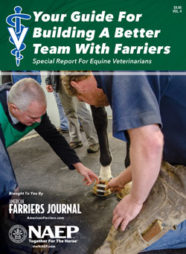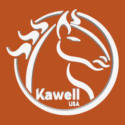Dozens of farriers and veterinarians gathered at the University of Tennessee College of Veterinary Medicine in Knoxville for the third-annual Equine Podiatry Conference. You can read more on this clinic in the July/August issue of American Farriers Journal and on the AFJ website. The clinic began on Friday, May 20 with a presentation by university clinical instructor Dr. Jose Castro followed by a dissection led by the university’s farrier Dudley Hurst and associate professor Dr. Steve Adair. Dr. Scott Pleasant and Travis Burns from the Virginia-Maryland College of Veterinary Medicine provided additional insight to this dissection in relation to their upcoming presentations on palmar foot pain and strategies on addressing it. In this wet lab, groups of farriers were provided with a cadaver leg, which they dissected under Hurst’s guidance
On the 21st, Hurst welcomed attendees to the conference. Each year, the vet school brings a farrier and veterinarian who work together on a daily or frequent basis to discuss a particular foot issue. Hurst says because each approaches the problems from different perspectives, there is much to learn from this interaction.
Dr. Dan Burke of Tribute Equine Nutrition gave advice on body condition scoring and weight management. Burke, the director of Tribute, says as a guideline for ideal bodyweight, he likes to be able the feel the ribs but visibly distinguish them. He does note that this is a personal preference and other factors, including discipline, may affect what others consider more ideal and telltale signs. Before beginning his lecture, Pleasant added that farriers should be willing to “politely” discuss with owners whose horses are falling outside a healthy margin. If uncomfortable with this discussion, he added that alerting the horse’s veterinarian to this issue is appropriate.
Pleasant presented on the “Diagnosis and Management of Palmar Foot Pain.” After reviewing the anatomy, the veterinarian discussed the stresses and strains on the navicular apparatus. He then surveyed a couple of categories why navicular disease occurs. He noted that life isn’t always as easy, but confining the discussion to these two simplifies the discussion of why. Painting a scenario of a high-quality horse that at some time is diagnosed with navicular disease.
“The navicular area is high wear and tear — the highest in the fore limbs,” says Pleasant. “It is like a perfect car — it will at some point break down.” In this scenario, the distal limb conformation is normal, but abnormal loads are applied to the navicular apparatus. Examples of contributing factors to this could be advanced age, body condition, overuse and erratic use. Of this last example, Pleasant adds that the body will only put enough resources into tissues that it needs.
“It’s going to judge this by the stresses and strains that are placed on it,” he says. “Bones will accommodate what you do. So if a horse does nothing for 6 days a week and then goes on an endurance ride on Sunday, the tissue won’t be ready for that.”
The other category occurs when loads are reasonable, but conformation is inferior, resulting in abnormal loading. This includes an upright foot, underrun or a small foot for the body size. Next, Pleasant discussed the advanced imaging options for diagnosing issues with the navicular apparatus, including radiographs, scintigraphy and MRI. He explained how each adds to the puzzle of trying to identify the issues.
Following this, Burns outlined treatment of palmar foot pain. He surveyed how farriers should examine a foot, reminded that in absence of radiographs, understanding the external structures is critical. In discussing the principles of farriery, Burns talked about the need for farriers and vets to work together. He feels that conflict can occur between the practitioners when one dictates specific techniques to the other, such as a vet dictating a specific shoe and pad combination.
“That’s unfair to the farrier, who may not be comfortable with that option,” he says. “Techniques should be a shared decision.” Burns reviewed several considerations of shoeing options available to the farrier when addressing issues with the navicular apparatus. It is imperative to always understand what you want the shoe or pad to accomplish before you settle on it as part of a solution.
Burns also advocates understanding the various products available as more tools in the toolbox can improve your chance for success in addressing navicular issues. After this, the vet-farrier team presented two cases encountered at their clinic. Their goal was to encourage the farriers in attendance to think of addressing navicular apparatus problems based on principle rather than a single solution or shoe choice when presented with all of the information. After lunch, they shod a live horse, Pleasant and the University of Tennessee team captured radiographs with the old shoes on, and then with the shoes off following a rough trim by Burns. Pleasant led a discussion with the attendees on the radiographs and what a presiding veterinarian would consider. Burns then led the discussion of the farrier’s role, and with the attendee’s input, glued cuff shoes on the fores and hot fit steel shoes on the hinds.
Sponsors of this clinic were Farrier Product Distribution, Soft Ride and Tribute Equine Nutrition. Trade show exhibitors included 3M, Big Anvil, Dechra, Easy’s Slipper, Epona Shoe, Hanton, KineticVet, Life Data Labs, St Croix Forge, Stockhoff’s Horseshoes and Supplies, Tennessee Farrier Supply, Vetoquinol and Vettec.







